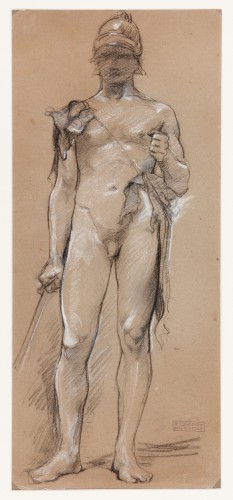Spanish Old Master Drawings
Study of a Warrior
Ricardo Villodas y de la Torre
(Madrid, 1846-Soria,1904)
- Charcoal and white lead on paper
- 455 x 255 mm
- Inscribed: with the artist’s estate stamp (lower right corner)
- SOLD
Ricardo Villodas was born in Madrid in 1846. He began his artistic training at the early age of fourteen at the School of the Royal San Fernando Fine Arts Academy, where he studied with the painter Federico de Madrazo (1815-1894), one of the leading figures and most celebrated names in 19th-century Spanish painting. Villodas’ training involved copying the works of the Old Masters in the Prado, attending classes at Eduardo Rosales’ studio (1836-1873), and taking part in various competitions and exhibitions. In the Regional Exhibition of Zaragoza, for example, in which Villodas competed at the age of only eighteen, he was awarded a third prize for the canvas The Italian Boy, gaining a medal and a study trip to Paris. Villodas stayed in Paris for twelve years, during which time he made contact with other Spanish artists awarded State travel grants, including Raimundo de Madrazo, León Bonnat and Eduardo Zamacois. In 1876 he returned to Madrid and won a second prize medal at the National Exhibition for The Death of Caesar. 1 He would be awarded the same prize two years later for A Message from Charles I to Cardinal Cisneros (Museo Nacional del Prado, on deposit with the City Council of Albacete, inv. no. 7010). The latter is painted in the historicist style typical of Spanish painting of the second half of the 19th century. Following these successes, Villodas decided to go to Rome, where he remained for twenty years, maintaining close contacts with Spaniards living there. In Rome he attended José Casado de Alisal’s classes at the Spanish Academy and those at the Chigi Academy. He took part in the informal intellectual discussions at the Café Greco and was frequently to be found in the studios of José Villegas and Lorenzo Vallés. While living in Rome Villodas continued to enter works for the National Exhibitions in Spain, winning his last award (a first class medal) in 1887 for Victoribus Gloria. A Naumachia in the times of Augustus (Soria, Town Hall), a composition in the Pompeiian style that earned him international recognition.
read more
Within his oeuvre Villodas combined the academic discipline of history painting, the only genre that could bring artists official recognition, with the execution of smaller, cabinet paintings on a variety of themes including scenes of picturesque daily life, Orientalist subjects, and Pompeian figures. Financial difficulties obliged Villodas to return to Spain in 1888, where he secured the patronage of Alfonso XII who made him a Knight of the Order of Charles III. In 1889 the artist moved to Soria, remaining there until his death in 1904 and painting portraits, landscapes and religious compositions in a style essentially derived from the Baroque.
Drawing played a key role in Villodas’ training. The two drawings on the recto and verso of the present sheet correspond to his years of training in which drawing from life, copying classical statues and copying the work of the great masters of the past were traditional activities for students at art academies. Both are executed in charcoal and white lead but are completely different in character. While the figure of the Warrior (verso) conforms to traditional academic practice in its detailed study of light and shadow and of the figure’s anatomy and folds of the drapery, Seated Woman (recto) is executed in an unusually free, deft and modern style. The forms are lightly suggested by the charcoal while the white lead creates the sensation of a heavily folded tunic. With these two drawings Villodas reveals the two facets of late 19th-century art: on the one hand the existence of an academic tradition that continued to esteem strict and rigorous training and which saw the execution of large, historical compositions as the only way for artists to achieve prestige; and on the other, the new modern approach that was manifesting itself through the art movements of the second half of the century, such as Impressionism and Post-impressionism, and which heralded the creative freedom of the early 20th-century avant-garde movements.
The most important surviving group of drawings by Villodas is in the Library of the University of Navarre and takes the form of a notebook of 53 sketches. They cover a wide range of themes from portraits to landscapes, exotic, Orientalist figures, allegorical and Pompeian figures and academic figures studies. The series reveals the two different facets of 19th-century art noted above as it includes drawings of an academic nature such as The Swordsman and The African with others that approach Impressionism and avant-garde art such as Café Scene and Country Scene. Both the drawings in the University of Navarre notebook and the present drawings are unsigned but all have the artist’s estate stamp, which was added after his death. Signed drawings include two in the Mapfre Collection: A Senator, which is a preliminary study for The Death of Caesar, and a Young female Nude, depicted in the manner of a classical maenad. Both works reveal Villodas’ great technical skills and his particular preference for theatrical gestures and expressions.
[1] Ossorio y Bernard, Manuel, Galería Biográfica de artistas españoles del siglo XIX. Madrid, Giner, 1975, p. 700.


